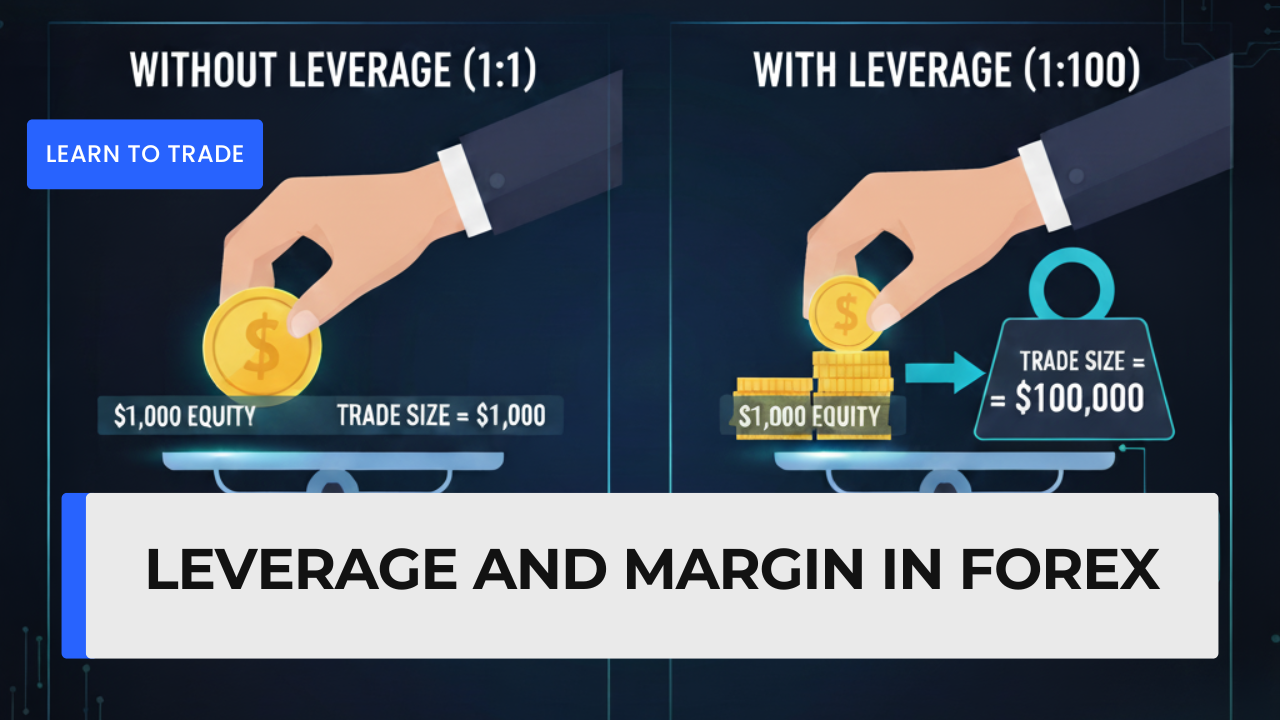Understanding How Small Investments Can Control Big Trades
One of the most powerful features in forex trading is leverage — it allows traders to control larger positions with a smaller amount of money. But to use leverage effectively, you also need to understand margin, which is the amount of your own capital required to open and maintain those positions.
Used wisely, leverage can boost your profits. Used carelessly, it can magnify your losses. Let’s explore how both concepts work and what every trader should know before using them.
1. What Is Leverage in Forex?
Leverage is essentially borrowing money from your broker to increase the size of your trade.
It allows you to control a larger amount of currency with a smaller initial investment.
Example:
If your broker offers 1:100 leverage, it means you can control $10,000 worth of currency with just $100 of your own money.
So, with 1:100 leverage:
- Your trading power = 100 times your capital
- Your potential profit and potential loss are both multiplied by 100
Simple Analogy
Think of leverage like a property mortgage.
You might pay a small down payment to control a large asset (a house), but you still owe the bank for the rest.
In forex, your margin acts as the down payment, and the broker “lends” you the rest through leverage.
2. How Margin Works
Margin is the amount of money you must deposit with your broker to open a leveraged position.
It’s not a fee — it’s a security deposit that ensures you can cover potential losses.
Example:
If you want to open a $10,000 trade and your broker offers 1:100 leverage, you only need 1% margin (which is $100).
If the trade moves in your favor, your profits are based on the full $10,000 position — not just your $100.
But if the market moves against you, your losses are also based on that same full amount.
Margin Call and Stop-Out Levels
If your losses reach a certain point and your account balance falls below the required margin, the broker will issue a margin call — a warning that you need to deposit more funds.
If you don’t, the broker may automatically close your trades to prevent further losses.
Infographic Idea:
Progress bar showing:
- Green Zone → Safe Margin
- Yellow Zone → Margin Call
- Red Zone → Stop-Out Level
3. Pros and Cons of Using Leverage
Leverage can be a double-edged sword — it offers powerful opportunities but also carries significant risk.
Advantages of Leverage
- Trade Bigger with Less Money – Control large positions with small capital.
- Higher Profit Potential – A small price move can result in significant gains.
- Flexibility – You can diversify trades even with limited funds.
💡 Example: With $500 and 1:100 leverage, you can open trades worth up to $50,000.
Risks of Leverage
- Magnified Losses – Just as leverage multiplies profits, it also multiplies losses.
- Margin Calls – If the market moves against you, you may be forced to close trades or deposit more funds.
- Emotional Pressure – High leverage can cause traders to overtrade or panic during volatility.
Tips for Using Leverage Safely
- Start with low leverage (e.g., 1:10 or 1:20) until you gain experience.
- Always use stop-loss orders to limit potential losses.
- Never risk more than you can afford to lose.
- Focus on consistent strategy and risk management, not just high returns.
At Holo Forex, we teach traders how to balance opportunity with discipline — because smart trading is about control, not gambling.
Key Takeaways
✅ Leverage increases your trading power by letting you control larger positions.
✅ Margin is the security deposit required to open those positions.
✅ Higher leverage = higher risk — profits and losses are both amplified.
✅ Proper risk management and discipline are essential for long-term success.
Final Thoughts
Leverage and margin are the engines that power the forex market. They make trading accessible, exciting, and full of opportunity — but only for those who understand how to manage them wisely.
At Holo Forex, we believe education is the first step toward confidence.
Learn the mechanics, manage your risk, and trade with strategy — because smart use of leverage can turn a small account into a strong trading journey.


